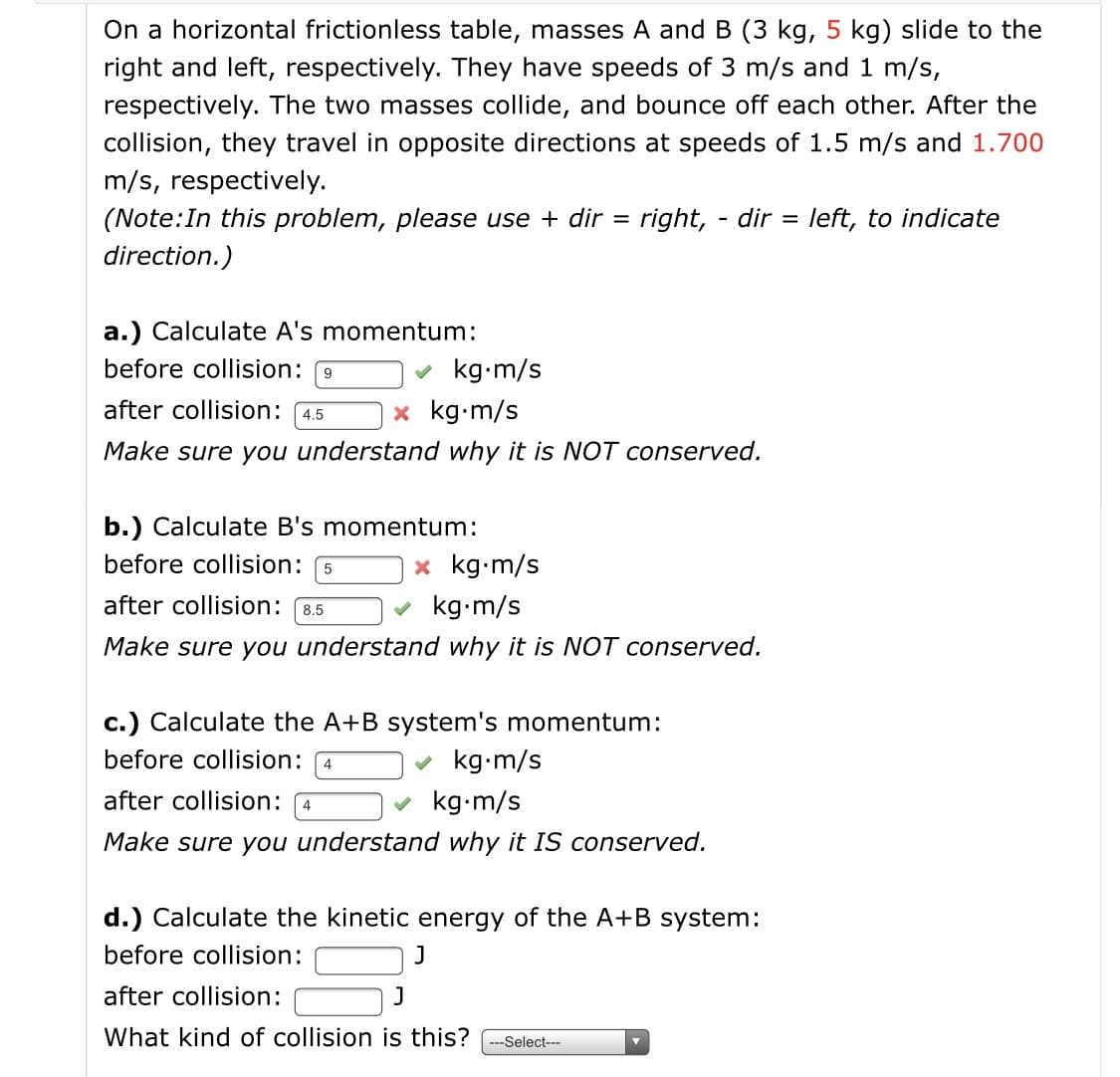On a horizontal frictionless table, masses A and B (3 kg, 5 kg) slide to the right and left, respectively. They have speeds of 3 m/s and 1 m/s, respectively. The two masses collide, and bounce off each other. After the collision, they travel in opposite directions at speeds of 1.5 m/s and 1.700 m/s, respectively. (Note:In this problem, please use + dir = right, - dir = left, to indicate direction.)
On a horizontal frictionless table, masses A and B (3 kg, 5 kg) slide to the right and left, respectively. They have speeds of 3 m/s and 1 m/s, respectively. The two masses collide, and bounce off each other. After the collision, they travel in opposite directions at speeds of 1.5 m/s and 1.700 m/s, respectively. (Note:In this problem, please use + dir = right, - dir = left, to indicate direction.)
Principles of Physics: A Calculus-Based Text
5th Edition
ISBN:9781133104261
Author:Raymond A. Serway, John W. Jewett
Publisher:Raymond A. Serway, John W. Jewett
Chapter11: Gravity, Planetary Orbits, And The Hydrogen Atom
Section: Chapter Questions
Problem 57P
Related questions
Topic Video
Question

Transcribed Image Text:On a horizontal frictionless table, masses A and B (3 kg, 5 kg) slide to the
right and left, respectively. They have speeds of 3 m/s and 1 m/s,
respectively. The two masses collide, and bounce off each other. After the
collision, they travel in opposite directions at speeds of 1.5 m/s and 1.700
m/s, respectively.
(Note:In this problem, please use + dir = right, - dir = left, to indicate
direction.)
a.) Calculate A's momentum:
before collision: 9
kg-m/s
after collision:
x kg-m/s
4.5
Make sure you understand why it is NOT conserved.
b.) Calculate B's momentum:
before collision:
x kg-m/s
5
after collision: 8.5
kg-m/s
Make sure you understand why it is NOT conserved.
c.) Calculate the A+B system's momentum:
before collision:
v kg-m/s
after collision: (4
kg-m/s
Make sure you understand why it IS conserved.
d.) Calculate the kinetic energy of the A+B system:
before collision:
J
after collision:
What kind of collision is this?
-Select---
Expert Solution
This question has been solved!
Explore an expertly crafted, step-by-step solution for a thorough understanding of key concepts.
Step by step
Solved in 4 steps

Knowledge Booster
Learn more about
Need a deep-dive on the concept behind this application? Look no further. Learn more about this topic, physics and related others by exploring similar questions and additional content below.Recommended textbooks for you

Principles of Physics: A Calculus-Based Text
Physics
ISBN:
9781133104261
Author:
Raymond A. Serway, John W. Jewett
Publisher:
Cengage Learning

College Physics
Physics
ISBN:
9781305952300
Author:
Raymond A. Serway, Chris Vuille
Publisher:
Cengage Learning

Physics for Scientists and Engineers
Physics
ISBN:
9781337553278
Author:
Raymond A. Serway, John W. Jewett
Publisher:
Cengage Learning

Principles of Physics: A Calculus-Based Text
Physics
ISBN:
9781133104261
Author:
Raymond A. Serway, John W. Jewett
Publisher:
Cengage Learning

College Physics
Physics
ISBN:
9781305952300
Author:
Raymond A. Serway, Chris Vuille
Publisher:
Cengage Learning

Physics for Scientists and Engineers
Physics
ISBN:
9781337553278
Author:
Raymond A. Serway, John W. Jewett
Publisher:
Cengage Learning

Physics for Scientists and Engineers with Modern …
Physics
ISBN:
9781337553292
Author:
Raymond A. Serway, John W. Jewett
Publisher:
Cengage Learning

Physics for Scientists and Engineers: Foundations…
Physics
ISBN:
9781133939146
Author:
Katz, Debora M.
Publisher:
Cengage Learning

University Physics Volume 1
Physics
ISBN:
9781938168277
Author:
William Moebs, Samuel J. Ling, Jeff Sanny
Publisher:
OpenStax - Rice University